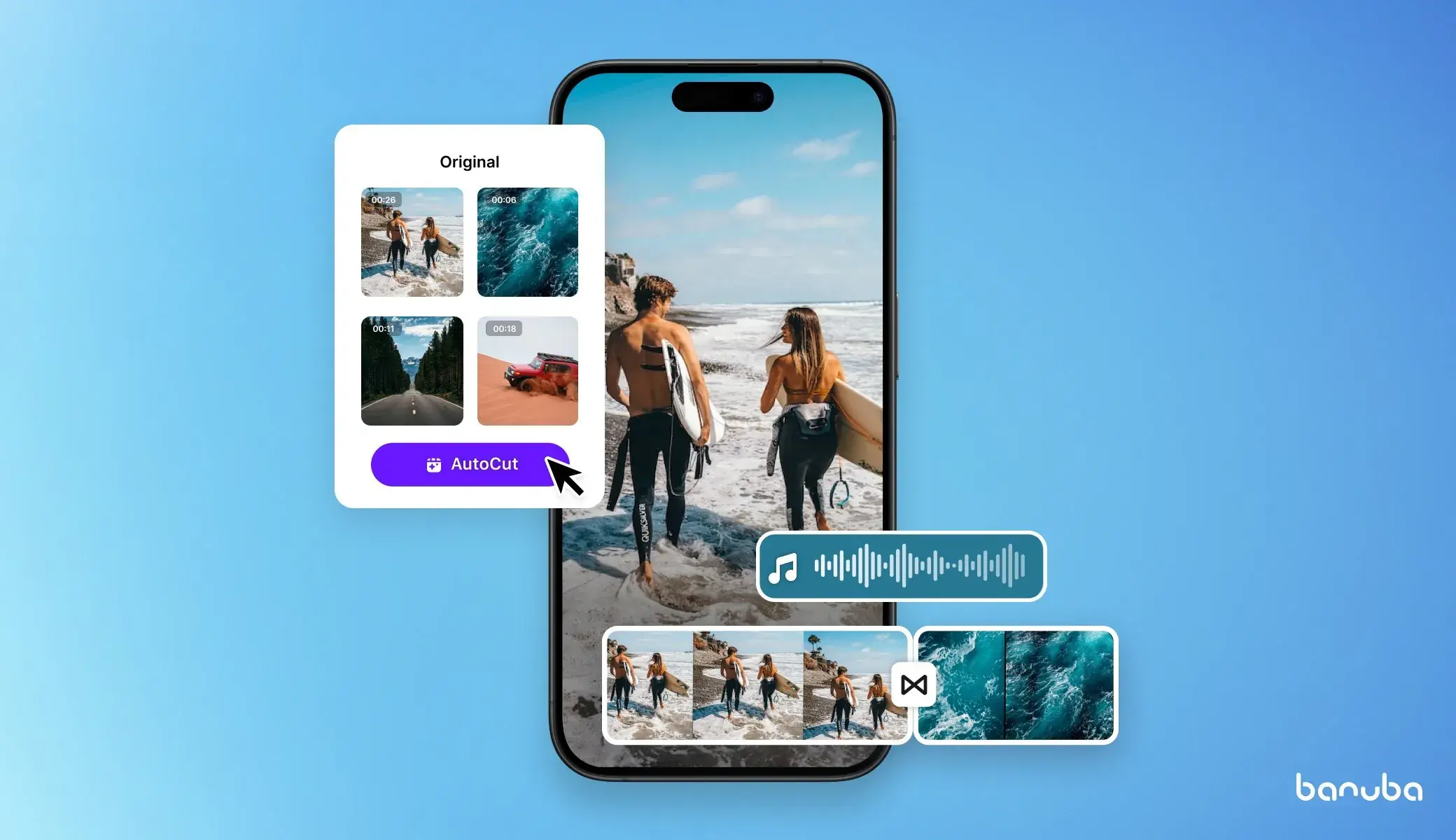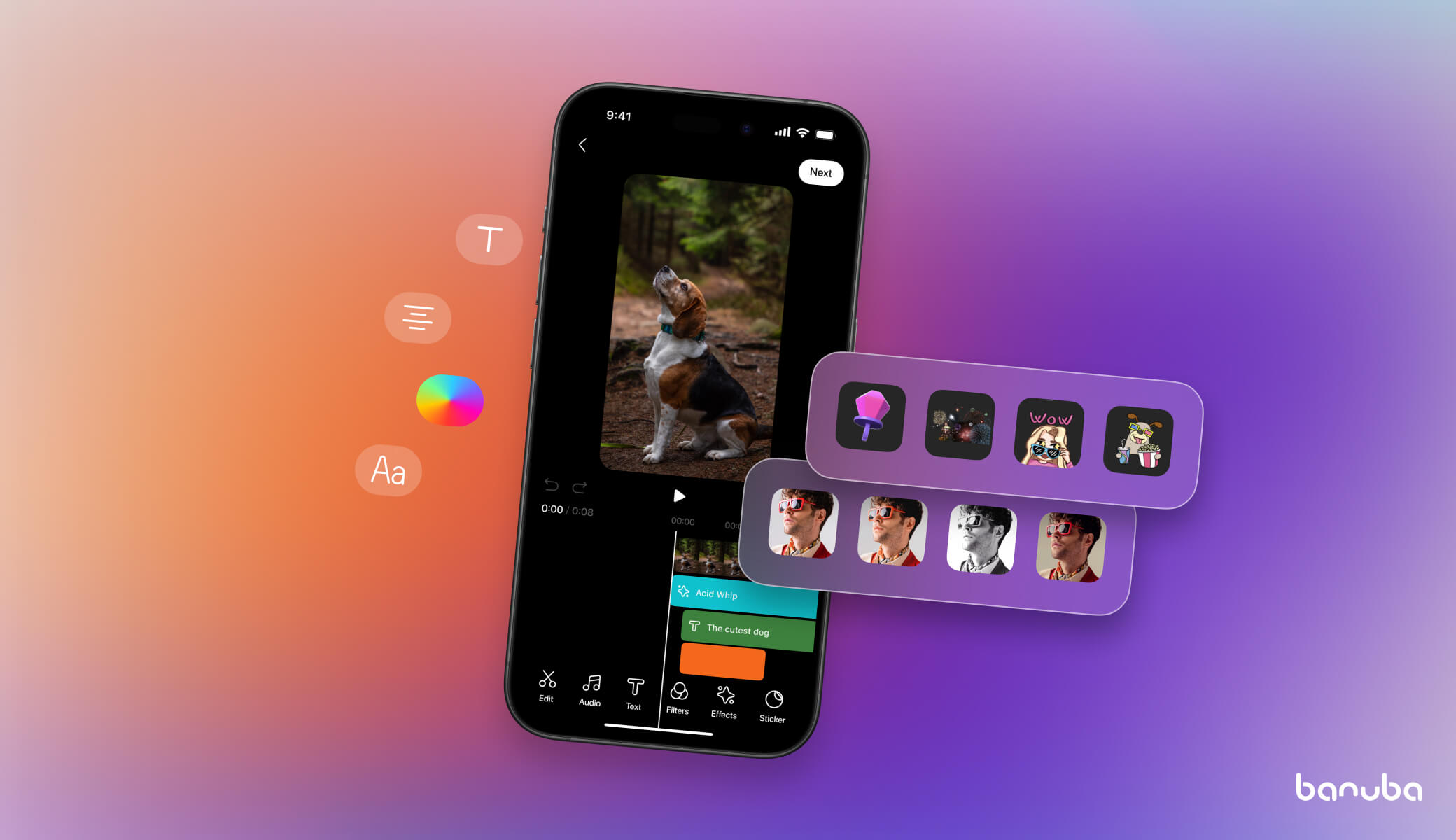How To Build an App Like Capcut with Video Editor SDK
With platforms like TikTok, YouTube, and Instagram driving the demand for engaging and creative videos, the consumption of such content is at an all time high. One app that has gained immense popularity in the realm of creating and editing videos is CapCut, with over 500 million downloads per platform. However, building similar software is no small feat, as it involves navigating the complexities of video editing, integrating advanced features, and ensuring seamless user experience. In this article, we will show you how to speed up building a video editing app like CapCut by using a video editing SDK.

[navigation]
TL;DR:
- CapCut is popular because it's backed by TikTok, free, user-friendly, and has many useful features;
- Developing a similar app from scratch is possible, but will likely take a lot of time and effort;
- Using a video editing SDK will shorten the time-to-market and decrease the necessary budget.
Why is CapCut successful?
TikTok wasn’t the first platform to promote short videos (remember Vine?). However, it was the first to transform short-form creation into a mainstream, global behavior. CapCut, owned by the same parent company, extends this ecosystem by giving users a streamlined and highly efficient mobile editor built around TikTok-native workflows.
From a product-engineering perspective, CapCut succeeds because it blends intuitive UX patterns with advanced, high-performance capabilities. Its interface favors real-time preview, drag-and-drop actions, gesture-driven trimming, and low-friction template workflows. These design choices significantly reduce cognitive load, making the app accessible to beginners while remaining fast enough for heavy creators.
Beyond UX, CapCut’s core strength lies in its feature depth. The app integrates AI-powered functionality—such as automatic captions and background removal—directly into the editing pipeline. This aligns with modern user expectations shaped by short-form platforms where creators expect instant, automated assistance rather than manual adjustments.
CapCut’s underlying user experience design prioritizes:
• fast edit cycles
• instant preview rendering
• seamless timeline navigation
• non-destructive editing
• minimal time between import → edit → publish
These UX principles directly influence how developers must architect caching, media pipelines, GPU acceleration, and multi-layer video timelines when replicating similar functionality.
Key features of CapCut include:
• Intuitive editing tools such as trim, cut, merge, and speed adjustment
• A wide range of filters, effects, and transitions to enhance videos
• Customizable text and stickers to personalize creations
• A large music library for fast sound syncing
• Easy export and sharing to TikTok, Instagram, YouTube, and other platforms
Overall, CapCut’s popularity comes from its combination of powerful editing tools, AI-driven enhancements, and an efficient user experience that dramatically shortens time-to-publish—qualities that any CapCut-like app must replicate.
Core Features Required for a CapCut-Like App
Basic Editing Features
These include trimming, cutting, merging, speed control, and multi-layer timeline editing. Without these baseline capabilities, the app cannot replicate CapCut-level editing flows.
Creative Assets
Users expect large libraries of transitions, effects, filters, stickers, and text overlays. These “creative layers” dramatically influence time-to-publish for short-form content.
Advanced Tools (AI-Powered)
Modern users require capabilities such as:
• AI-generated captions
• Background removal
• Keyframe animation
• Smart cropping / auto-beat sync
These features require ML pipelines, GPU acceleration, or integration with a pre-built SDK such as Banuba.
User Experience and UI/UX Design
Strong editing apps rely on interaction patterns such as:
• non-destructive editing
• real-time feedback
• gesture-driven trimming
• template-based editing
Developing these flows from scratch can take months.
Export & Sharing Options
High-quality export (1080p/4K) and direct sharing to TikTok, Instagram, and YouTube are non-negotiable. This requires controlled rendering pipelines and optimized encoding.
How to copy it
If you want to build a similar trending video editor apps or integrate such features into a different one (a social and travel app, for example), you have two main options: creating everything from scratch or integrating a video editor SDK.
DIY
Choosing this approach means developing similar functionality from the ground up. This is possible either through your in-house IT team or by hiring a software development company.
Choosing the Right Tech Stack
Frontend Technologies
Native:
• Swift for iOS
• Kotlin/Java for Android
Cross-platform:
• React Native
• Flutter
Backend Technologies
If you extend editing with cloud sync or user accounts, a backend is required:
• Node.js for server-side APIs
• Authentication, projects storage, user metadata
Video Processing Libraries
FFmpeg or equivalent media processing libraries are required for:
• encoding/decoding
• trimming
• composition
• GPU-accelerated filters
Cloud Services
AWS or GCP are typically used for:
• cloud rendering (if needed)
• user project storage
• analytics pipelines
Development Phase (Frontend + Backend)
Once the tech stack is chosen, developers build the timeline editor, effect layers, rendering pipeline, and UI workflows. This phase typically includes:
• timeline implementation
• integration of media processing libraries
• UI logic for trimming, merging, filters, audio control
• asset management system
Quality Assurance (Testing)
Video editing requires stress-testing:
• device fragmentation (Android especially)
• GPU/CPU performance
• memory usage under long multi-layer edits
• export stability
Comprehensive QA prevents crashes during rendering — the most common failure point for DIY editors.
Pros:
- More control. You get to choose the priorities, features for the minimum viable product, technologies, etc.
- Complete ownership. Software that your team has built (or that you paid someone to build) is your intellectual property. It has its own value and can increase the valuation of your company, should you decide to take it public.
- Unique features. You can decide to include something that no SDK has and make this plan a reality.
- Development risks. What if the offshore development company that you’ve hired to build an app like CapCut goes bankrupt? What if your most experienced in-house developer leaves? There are plenty of ways things can go wrong, and all the risks are on you to manage.
Cons:
- Higher initial investment. Software development costs money. Depending on the team you use and the scope of work, making an app like CapCut could cost over $250.000. You will have to bankroll the development efforts with no guarantee of success.
- Longer time-to-market. Creating a video editor could take months. In this time, your competitors could already get listed and start receiving user feedback and cash flow.
- Responsibility. You will have to spend money on maintaining your CapCut-like app. The tech world is moving forward, and you’ll need to keep up to engage users and ensure that your software works as intended.
In general, this approach is more suited for a larger companies with appropriately large budgets and experienced development teams.
Use an SDK
A software development kit (SDK) is a ready-made module with the necessary functionalities that you can quickly integrate into your project. Imagine that you are making a car. Instead of designing and producing an engine, you just buy one from a reliable manufacturer and install it. The idea is the same.
Pros:
- Lower initial costs. A yearly SDK license is a small fraction of the development cost for a CapCut-like app. This means that you can spend your budget on other things (e.g. user acquisition) and risk losing less, if the idea doesn’t gain enough traction.
- Quicker release. Integrating a well-packaged software development kit takes less that a working day. You’ll be able to test everything and launch your app before your competitors.
- More features. Releasing an entirely new product necessitates a limited feature set. A commercial SDK that has been available for a few years will have way more functionalities.
- Support and updates. The company that developed the SDK is responsible for maintaining it in working condition.
Cons:
- Limited customization. SDKs are one-size-fits-all by necessity. If you want something entirely different and unique, you’ll have to build it yourself.
However, there are options. For example, Banuba Video Editor SDK has an API version that has fewer features out-of-the-box, but offers more space for customization. - Similarity to other projects. Other companies will be using the SDK you’ve chosen. This means your product’s interface will look similar to others. This can hurt your brand recognition somewhat.
SDKs are a better way forward for small and medium businesses, as well as companies that don’t specialize in software development or want to limit their risk exposure.
Integrating an SDK
In this case, we will be using Banuba Video Editor SDK, as it fits the purpose the best.
About Banuba Video Editor SDK
Banuba Video Editor SDK is a full-fledged suite for creating and editing short-form audiovisual content. It comes prepackaged with many impressive features:
- Trimming/merging
- Drafts
- Audio editing
- Background replacement
- Color filters
- 3D masks
- Rapid/slo-mo
- Picture-in-picture (duets)
- AI-generated captions
- Etc.
It is compatible with native Android and iOS, as well as React Native and Flutter. So it will fit no matter what you use for your project.
The SDK provides core editing functionality out-of-the-box, removing the need to build timelines, media pipelines, GPU filters, and AI layers manually. For engineers, the main advantage is eliminating months of low-level processing work by relying on Banuba’s optimized C++ media engine.
Video Editor SDK is designed to be easy to implement. The entire process takes a few hours, and in some cases – about 8 minutes. Its features are simple for developers to modify and have a thorough documentation.
It also fulfills all the privacy requirements (e.g. GDPR) by design, as this product doesn’t collect user data and processes almost everything on the user’s device – AI-generated subtitles are the only exception.
Integration
The first step is to request the SDK archive and the trial token. This way you’ll be able to test this product for 14 days, no credit card required. Simply send us a message through a contact form below.
The second step is to merge the SDK with your project. It is distributed as CocoaPods or Maven packages (depending on the platform) to speed up integration. See the detailed updated instructions below (links to GitHub):
Banuba distributes the SDK as CocoaPods (iOS) and Maven packages (Android), enabling safe dependency management for large codebases. Flutter and React Native bindings ensure cross-platform teams can reuse existing UI layers while accessing native-quality video performance.
Once you are ready to buy a license, you will be able to afford it. The pricing of Banuba Video Editor SDK is based on the feature set, the number of monthly active users, and supported platforms, and the license costs low enough to fit the budget of a mid-sized business.
Conclusion
Building a CapCut-like app involves far more than UI—successful products rely on efficient video pipelines, strong UX patterns, and continuous updates. Given the complexity of modern editing stacks, using a pre-built Video Editor SDK significantly reduces engineering load, time-to-market, and long-term maintenance risks.



